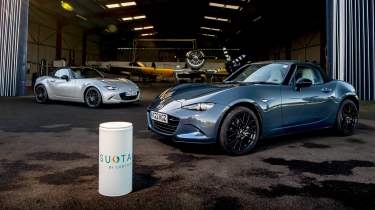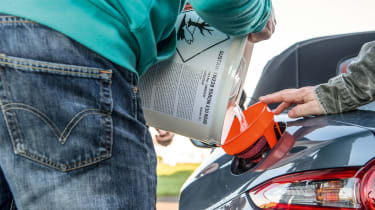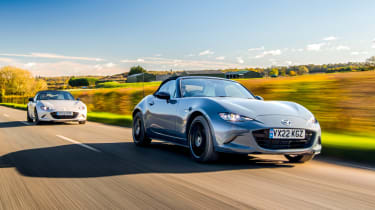Synthetic fuel v regular unleaded: sustainable petrol put to the test
Could sustainable synthetic fuels be the green way to keep millions of ICE-powered vehicles on our roads? We run a back‑to‑back test between an advanced biofuel and regular unleaded and look at the science involved
'It does not pay a prophet to be too specific.’ So said science fiction author L Sprague de Camp, and following his advice, I will give a loose prediction that the adoption of EVs will hit the buffers within the next couple of years and certainly before the end of the decade.
The simple facts are these: EVs are getting more and more expensive, the public charging network is laughable and 40 per cent of UK households do not have off-street parking (the author included). What all this means is that there is certain to be a huge number of ICE cars around for decades to come. Indeed, the average age of vehicles in the UK car park is already increasing.
> Synthetic fuels explained: is there such a thing as carbon neutral petrol?
The government’s blinkered approach to reducing the car’s impact on the environment has got to be thrown aside so that other technologies – such as hydrogen and, most importantly, sustainable fuel – are properly considered. The latter in particular because petrol- and diesel-powered vehicles will be on our roads for several decades after sales of new ones are banned. And with them will be the cars that we cherish. I’m into internal combustion engines, which is why I have a car, a motorcycle and an aeroplane. I’ve driven every EV on the market today and not one fulfils my emotional needs.
I have already driven a car powered by sustainable petrol. The fuel is called Sustain, and it’s made by a company called Coryton. Last summer, Coryton together with the Historic and Classic Vehicles Alliance (HCVA) and Jaguar specialist SNG Barratt arranged for me to drive an E‑type running on Sustain fuel. The car ran faultlessly, but in truth it wasn’t the ideal test because, firstly, I hadn’t driven an E-type for quite a while and, secondly, the test car was substantially modified with electronic fuel injection and engine management so it ran a lot better than an original anyway. A more scientific approach was required.
This time we have two identical Mazda MX-5s. One is evo’s long-term test car and the other is from Mazda’s press fleet (actually, our example has lowered suspension but that won’t make a difference here). Mazda’s own car has been run down to fumes and its tank filled with sustainable fuel. Our long-termer is full of regular E10 unleaded to EN228 98 RON specification, as is Coryton’s Sustain petrol.
John Barker, who actually paid attention at school and has certificates to prove it, is going to run you through all the deep tech, formulas and equations. But before Prof Barker takes over and we fire up the Mazdas, a quick explanation of where sustainable fuel comes from and the processes used to manufacture it.
The journey starts with ethanol that has been produced from biomass such as agricultural waste. The husks from sugar beet are one example, although you can make ethanol from any material that can be fermented. The first step is to degas the ethanol, which removes the oxygen and water, leaving only hydrogen and carbon. Next, these go through a series of catalysts that turn them into a hydrocarbon liquid.
The fuel that we’re using today contains ten per cent ethanol, which is simply achieved by putting the original raw ethanol back into the fuel. The ethanol is added for cost reasons and to get the performance required from the fuel.
Sustain looks like regular petrol and smells similar, even though it doesn’t have the same additives as the pump fuel. When it comes to driving the two cars there is absolutely no discernable difference between the MX-5s’ performance on their respective fuels. We start both from cold, and both start immediately. A quick sniff around the exhaust pipes and there’s no difference there, either. Out on the road, using exactly the same stretch of tarmac and driving each car at the same speed and throttle opening, the performance of the two cars is identical.
There is one difference between the performance of the two fuels, however, although it only comes to light later, after the sustainably fuelled MX-5 has racked up over 100 miles. This car is notably more economical, averaging 44mpg instead of 40mpg for exactly the same journey (back to Mazda HQ). This, says Coryton, is because the sustainable fuel is more energy-dense; you will hear more about this from Barker. After this initial experience we are planning more-exhaustive tests on a wider variety of engines.
The doubters will wonder if sustainable fuel will ever take off and whether we’ll be able to buy it from regular service stations. I’m confident on both counts because eventually the government is going to have to wake up to the reality of there being many millions of internal combustion engine cars still on the road. Meanwhile, don’t rush to replace the Metzger engine in your 911 with an electric motor and heavy batteries because a solution could well be on its way.
Coryton has already launched its first sustainable fuel for the public, initially distributed by Bicester Heritage. While formulated for classic vehicles, it can also be used by modern engines, with 98RON and 102RON options. Priced from £3.80 per litre is Super 33 (98RON and with at least 33 per cent sustainable content) – 98RON Super 80 is the most sustainable at 80 per cent renewable content, costing from £4.65 per litre, with 102RON Racing 50 utilising at least 50 per cent renewable content, from £5.24 per litre.
This story was first featured in evo issue 306.






